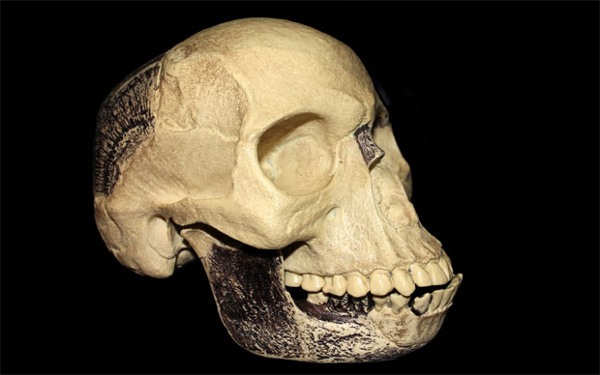Reversing the most cultivated science scam in history
This is a detective story about a case that existed hundreds of years ago: the falsification of the "lost link" in human evolution has not been revealed for decades.
Currently, researchers are expected to identify the long-dead perpetrators of the famous 'Piltdown' scam and topple their motives.
In this article published in Nature this week, expert Chris Stringer from the British National Museum of History in London explained why he and his colleagues are still investigating a secret that has been around since. 1 century.
'On the personal side, I was inspired by the question of whether this hoax originates from scientific ambitions or humorous or revenge motives?' Mr. Stringer wrote. He and his colleagues plan to test the fake bones obtained in Piltdown case by modern methods, to discover who is most likely to have created them and why.

Skull replica 'Piltdown people. (Photo: Telegraph)
History of a sophisticated scam
The hoax The Piltdown is one of the most successful scientific scams in history.
After Charles Darwin published "On the Origin of Species" in 1859, scientists tried to find fossil evidence of extinct human ancestors. They look for what are called "lost links" to fill in the gaps in the time chart of human evolution.
In December 1912, British paleontologist Arthur Smith Woodward and amateur antique collector Charles Dawson declared to the world that they had discovered an amazingly early early fossil at Piltdown, Brother. Strange specimens possess a human skull with a monkey-like jaw. It is scientifically named Eoanthropus dawsoni , but is commonly known as The Piltdown.
Dawson and Woodward also announced that, apart from Piltdown People, they have also found countless other interesting things like stone tools, mammal fossils and even an elephant skeleton. In 1916, Dawson claimed to have found more artifacts in a nearby second place.
According to expert Stringer, some scientists have raised many questions to discover Piltdown. They did not immediately boo it as a lie, but suspected simple fossils were mixed over time, namely that the monkey and human-like skulls were not related to each other.
However, it was not until the 1950s that 'Piltdown' was discovered. Chemical studies show that fossils less than 50,000 years old, not 1 million years old like Dawson and Woodward once claimed. Subsequent tests reveal, the skull is most likely of a modern person and the jaw may belong to a modern chimpanzee.
Who is the culprit?
The question is, who made the bones discolored so that they fit together and honed the teeth that look more human-like?
That is the secret that Mr. Stringer and his colleagues hope to solve by means of radioactive carbon dating, DNA testing and other molecular studies. If researchers can determine the origin of the bones used to create fake fossils, they can identify any archaeologist of the project as the steward of everything.
For example, if the fossil fossils came from Piltdown and the second area that Dawson discovered coincided, the amateur antique collector might be the culprit because he was the only one who discovered the place. two, expert Stringer wrote. Mr. Dawson's motivation is most likely derived from his scientific ambition and his desire to build a reputation.

This portrait picture shows many important characters in the discovery of 'Piltdown People'. The following products include FO Barlow, G. Elliot Smith, Charles Dawson, Arthur Smith Woodward. Previous products include AS Underwood, Arthur Keith, WP Pycraft and Sir Ray Lankester.
Although a total of 12 suspects were accused in the fraud, there were three particularly suspicious people, in addition to Dawson. One of them was Woodward, because Woodward's assistant, Martin Hinton, after his death, was found to have a modified collection of bone fragments and discolorations. A priest named Teilhard de Chardin, who discovered a tooth at Piltdown, may also be involved.
Even celebrities cannot escape being suspected. The BBC reported that British writer Sir Arthur Conan Doyle, the famous writer of Sherlock Holmes detective series, was also accused of disrupting the scam. Mr. Doyle lives near Piltdown and is a member of the archaeological association. He wrote about the ancient monkeys in his novel 'The Lost World' and may have been provoked to deceive the scientific community for their ridicule for one of his greatest passions. The remarkable point is, Mr. Doyle also believes in the existence of fiction.
The 100-year-old secret is not something new, but expert Stringer sees the incident as an important milestone in the history of science. Piltdown prank seems to make scientists less willing to accept primitive fossils like Astralopithecus africanus (aka 'Lucy' ), Stringer wrote.
However, the expert insists that the deception also shows that, even if it takes a lot of time, science will eventually discover the truth.
- Appear on the internet fraud
- The most famous bets in the history of science
- Google changed the logo to honor the first female engineer in the history of world science
- Promotion of the construction of the country's first science museum
- Improved mature medicine will appear after exactly 2 years
- Cinnamon cat entered the history of science
- Successfully cultivated seaweed varieties that taste like bacon
- For the first time in history, the aging process can be reversed, helping young people never grow old
- The odd misconceptions in science
- Himalayan Cordyceps endangered
- Nursery for Vietnam's first natural history museum
- Successfully cultured 14 precious medicinal mushrooms
 The most famous scientific failures in history
The most famous scientific failures in history Mysterious genius mechanic and the machine froze time
Mysterious genius mechanic and the machine froze time The son carries the 'bad gene' of genius Albert Einstein
The son carries the 'bad gene' of genius Albert Einstein Isaac Newton
Isaac Newton